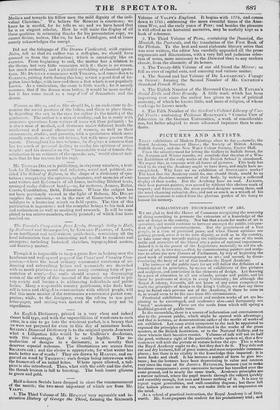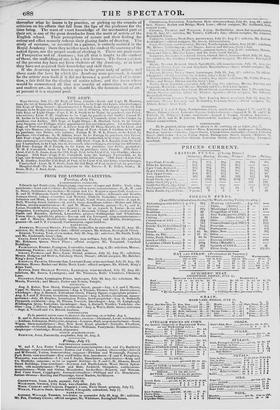PARLIAMENTARY ENCOURAGEMENT OF ART.
WE are glad to find the House of Commons recognizing the necessity of doing something to promote the extension of a knowledge of the arts of design in the country. Not but that a taste for works of art is spreading, and would continue to increase amongst the public, indepen- dent of legislative encouragement. But the government of a free pc:oplo, in a time of profound peace, and when liberal opinions are gainin.,b ground, owes it to its own dignity, as well as to the country, to take some step towards making the cultivation of one of the most noble and attractive of the liberal arts a point of national importance. Indeed it is in the power of the Legislature matetially to aid the ad- vance of art, in two ways,—first, by commissioning painters and sculp- tors to adorn the new houses of Parliament, by way of beginning the good work of national encouragement to art ; and second, by disen- cumbering the body of art of that incubus the Royal Academy. The increase of the public taste for art will follow the diffusion of a knowledge of its principles, by means of exhibitions of fine pictures and sculpture, and instruction in the elements of design. Let drawing be a part of education in all our schools, private and public, and let there be professors of design in every University ; for although the Royal A,..adeniy, forsooth, did not know of any artist competent to teach the principles of design in the King's College, we dare say there may be found such persons out of the Academy, if there be none in
it, as would seem to be the case from this circumstance. • Provincial exhibitions of ancient and modern works of art are be- ginning to be encouraged, and academies also—and fortunately not "royal" academies. These are the seeds from which will spring a healthful growth of public taste.
In the meanwhile, there is a source of information and entertainment also to the present public, which might be opened with advantage; and that is lectures, or demonstrations rather of the merits of works of art exhibited. Let some artist competent to the task be appointed to expound the principles of art, as illustrated in the works of the great masters, at the British Institution, or in the National Gallery, and to show wherein their beauties consist. Volumes of talk will not do half the good, without a sight of the particular works spoken of, that a few sentences will with the pictute or stature before the eye. This is what the Royal Academy ought to do; but they don't do it. They dole out cut and dry lectures, full of great names, and most respectable common- places; but there is no vitality in the knowledge thus imparted: it is were husks and chaff. It has become a matter of form to give lec- tures; but the lectures have been depreciating in value and interest ever since the time of Sir JOSIIUA REYNOLDS, because (not to make invidious comparisons) every successive lecturer has travelled over the same ground, and in nearly the same track. Academic principles are a narrow railroad, where the pupil travels through the subject quickly and smoothly enough, but sees and knows nothing of it. It is easy to repeat vague generalities, arid well-sounding dogmas; but these fall like hollow phrases on the ear, and make little or no impression on the mind. As a school of practical instruction, the Royal Academy is of little worth. Mr. Sass prepares the student for his probationary trial; and
thereafter what he learns is by practice, or picking up the crumbs of criticism on his efforts that fall from the lips of the professor for the time being. The want of exact knowledge of the mechanical part of their art, is one of the great drawbacks from the merit of artists of the English school. Their perceptions of nature and their feeling for colour and effect scarcely redeem their glaring faults of drawing. 'The study of costume, so essential to a painter, is entirely omitted in the Royal Academy : there they neither teach the student the anatomy of the naked figure, nor the proper mode of clothing it. There are professors of Perspective and of Anatomy; but all that is taught to the student of these, the scaffolding of art, is by at few lectures. The finest painters of the present day have not been students of the Academy, or at least they have not acquired their knowledge and skill there.
If the Academy were thrown open to the great body of artists, and these made the laws by which the Academy were governed, it would be the artists' own fault if it did not become a good school of in-trac- tion, a fair field for the display of native talent, and the focus where would be concentered all that was worthy of admiration in ancient and modern art-in short, what it should be, the fountain-head of art : at present it is a stagnant pool.



























 Previous page
Previous page